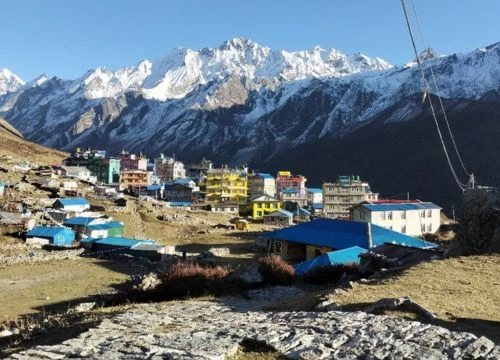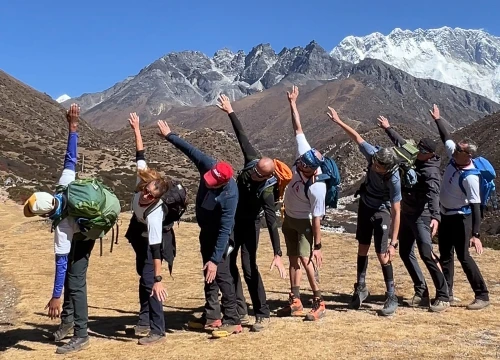Buying and Renting Trekking Gear In Kathmandu: What To Consider?
When preparing for a trek in Nepal, buying or renting gears is crucial step. However, each one has its advantages and disadvantages. So, it all comes to your decision that will depend on factors like budget, trek duration, and how often you plan to trek.
Buying trekking gear in Kathmandu is a great option if you are frequent trekker or have plan of multiple longer expeditions. So, owning your gear gives you the comfort of using items based on your preferences and needs. Kathmandu is a wonderful place to shop for trekking gear with internationally recognized brands stores to locally made options. Prices are often lower as compared to many other countries, making it easier to invest in quality items. However, it’s essential to inspect products carefully, as some counterfeit gear may be on the market. Buying is especially important for personal items like trekking boots, which need to fit well and be broken in before the trek.
Renting gear, on the other hand, is ideal for short trips or if you want to travel light. Kathmandu, particularly the Thamel area, is full of reliable rental shops offering everything from sleeping bags and jackets to trekking poles at affordable rates. Renting is a cost-effective option for expensive and specialized items like crampons which you may not need after the trek. Moreover, renting allows you to test equipment before deciding to invest on it.
In the end, the choice comes down to your trekking plans. If you’re a frequent trekker or need customized gear, buying makes sense. But if you’re on a budget or only trekking once, renting is a smart and convenient option. Hence, the availability of buying and renting trekking gear in Kathmandu provides excellent facilities for trekkers. This ensuring you’re well-equipped for your Himalayan adventure.
Where to Buy Trekking Gear In Kathmandu?
If you are gearing up for an adventure in Nepal, finding the right trekking equipment is essential. Luckily, the city, Kathmandu, has plenty of options for both seasoned hikers and first-timers. Here’s a guide to some of the top spots to shop for trekking gear in Kathmandu:
Thamel: A Trekker’s Haven
Thamel, the heart of Kathmandu’s tourist scene, is the ultimate destination for trekking gear. Its bustling streets are packed with shops offering everything from sturdy boots and warm jackets to sleeping bags and trekking poles. Popular stores like Shona’s Alpine and Mountain Hardware are trusted for their quality products. Whether you’re after branded gear or affordable local alternatives, Thamel has something for every budget and preference.
New Road and Indra Chowk: A Hub Where Tradition Meets Modernity
For a traditional shopping experience, you can head to New Road and Indra Chowk. An area that combine the charm of traditional marketplaces with modern stores that offers trekking essentials at competitive prices. While you might need to inspect items closely for its quality, but in doing so you can often snag some fantastic deals.
Local Markets: Budget-Friendly Finds
If you’re on a tight budget, Kathmandu’s local markets, such as Asan Bazaar, offer plenty of affordable options. While these items may lack big-brand labels, they can be surprisingly functional for shorter treks. Just make sure to check the stitching and material to ensure reliability before you buy.
Supermarkets and Department Stores: Convenient Essentials
Supermarkets like Bhat-Bhateni also stock trekking essentials, including socks, gloves, and water bottles. While their selection isn’t as extensive as specialized stores, they’re a convenient option for picking up smaller items you might have forgotten.
Where to Rent Trekking Gear In Kathmandu?
Kathmandu, a major trekking hub, not only offers plenty of opportunities to buy gear but also provides convenient rental options for those who prefer not to invest in equipment they may only use once. Renting trekking gear in Kathmandu is a practical and cost-effective solution especially for short-term trekkers. Here’s a guide to the best places to rent trekking gear in Kathmandu:
Thamel: The Ultimate Rental Destination
Thamel is the heart of Kathmandu’s trekking scene, making it the go-to spot for renting gear. Many shops in this area do have renting equipment facilities that offers everything from jackets and sleeping bags to trekking poles, backpacks, and crampons. Some popular rental stores include:
- Himalaya Gears
- Shona’s Alpine Rental
- Sports Wear International
- Mountain Hub Gear Rental
- Outdoor Compass Trekking Shop
- Himal Outdoor Store
- Goreto Gear Traders
- Affordable Alternatives at Indra Chowk and New Road
- Just a short distance from Thamel, Indra Chowk and New Road are great alternatives for renting trekking gear. These areas may not have as many shops as Thamel, but they offer competitive prices and good-quality equipment.
Essentail Trekking Gears Checklist
#Backpack ($50-$200)
Daypack: A smaller backpack for carrying essentials during day hikes.
Main Trekking Backpack: A larger backpack, typically 40-50 liters, suitable for multi-day treks.
Rain Cover ($5-$10): A protective cover to shield your backpack from rain.
#Clothing
Base Layer ($10-$30): Moisture-wicking garments, such as shirts and underwear, to keep you dry next to your skin.
Mid Layer ($20-$80): Insulating layers, like fleece or a down jacket, for added warmth.
Outer Layer ($50-$100): A waterproof and windproof outer layer, including a jacket and pants.
Trekking Pants ($20-$50): Durable, quick-drying pants designed for hiking.
Trekking Shirts ($10-$20): Quick-drying lightweight, breathable fabric shirts.
Socks ($5-$10): 3-4 pairs of merino wool or synthetic socks for comfort and blister prevention.
Gloves ($5-$30): A pair of light gloves for general use and a warmer pair for colder conditions.
Hat ($5-$10): A sun protection hat and a beanie for cold weather.
Buff/Neck Gaiter ($3-$10): A versatile piece of fabric that can be used as a neck warmer, face mask, or headband.
#Footwear
Trekking Boots ($50-$200): Sturdy, waterproof boots designed for hiking on rough terrain.
Camp Shoes ($10-$30): Easy-to-wear comfortable shoes or sandals around camp.
Gaiters ($10-$30): Leg coverings to protect your boots and legs from dirt, mud, and snow.
#Sleeping Gear
Sleeping Bag ($30-$100): The sleeping bag should have a temperature rating appropriate for the expected weather.
Mat ($15-$50): An insulated pad for comfort and warmth while sleeping.
Pillow ($5-$20): A pillow that's easy to pack and provides extra comfort while sleeping.
#Accessories
Headlamp/Flashlight ($10-$20): Bring a headlamp or flashlight and extra batteries for lighting.
Water Bottle ($5-$10): A durable water bottle, ideally insulated, with a capacity of at least 1 liter.
Water Purification ($5-$20): Bring items to clean your water, such as tablets, filters, or a Steripen, to prevent getting sick.
Trekking Poles ($10-$20): Adjustable poles to provide extra stability and support on uneven terrain.
Sunglasses ($10-$20): UV filter protection glass to protect from harmful sun rays.
Sunblock ($5-$10): At least SPF 50 sunscreen.
Lip Balm ($2-$5): With SPF 30 or more and thick consistency to protect from heat and cold.
First Aid Kit ($10-$20): A well-stocked first aid kit including essentials like pain relievers, blister treatment, and personal medications.
Camera: A camera to capture memories of your trek.
#Food and Snacks
Energy Bars: Energy-packed snacks to give you a quick burst of energy on the trail.
Trail Mix: A nutritious mix of nuts, dried fruits, and seeds for sustained energy.
#Personal Items
Toiletries: Essential toiletries such as a toothbrush, toothpaste, biodegradable soap, wet wipes, and other hygiene items.
Towel: A lightweight, quick-drying towel for personal use.
Personal Identification: Important documents such as your passport, permits, insurance information, and copies of these documents.
Cash: Nepali Rupees for expenses in villages and teahouses along the trek.
#Documents and Permits
Trekking Permits: You may need permits like the TIMS card and ACAP for your trek, so make sure to get them.
Travel Insurance: Make sure your travel insurance covers trekking and includes help if you need to be evacuated in an emergency.
#Miscellaneous
Multi-tool or Knife: A multi-tool or knife for various purposes, such as repairs or opening food packages.
Notebook and Pen: For journaling, making notes, or sketching during your trek.
Plastic Bags: Reusable plastic bags for separating wet clothes and keeping your gear organized.
By packing the right gear, you can ensure your trekking experience in Nepal is safe, comfortable, and enjoyable, while also being prepared for the challenging weather and terrain.
Tips For Buying and Renting Trekking Gear in Kathmandu
While purchasing the best trekking gears, you must consider following things:
- Take some time to learn about the items you need and their typical price ranges before you shop.
- Be cautious of counterfeit products. Always verify the authenticity of the items before making a purchase.
- When shopping in local stores or markets, don’t hesitate to haggle for a better deal.
- Check the durability and condition of items, especially clothing and gear. Look closely at zippers, seams, and fabric.
- Similarly, for renting trekking gears following tips might be helpful.
- Always check the condition of rented gear, including zippers, straps, and the overall fabric quality.
- Be clear about the rental duration, deposit requirements, and any potential penalties for damages or late returns.
- Prices can vary between stores, so take a moment to compare rates and find the best deal.
- During peak trekking seasons, rental gear can be in high demand. Booking in advance will ensure you get the gear you need.
Common Challenges and How to Avoid Them While Buying and Renting Trekking Gear in Kathmandu
When buying and renting trekking gear in Kathmandu, trekkers may encounter several challenges. So, being aware of these potential issues, you can make informed decisions before going on a shopping.
One of the primary concerns is ensuring the quality and authenticity of purchased gear. Some shops may offer counterfeit or substandard equipment that could fail during your trek.
How to avoid:
Prioritize reputable shops with positive reviews or recommendations from other trekkers.
Thoroughly inspect each item for any defects or signs of poor quality before making a purchase.
Finding the correct size and style for essential items like trekking boots and jackets, can be challenging. Shops may not always have the specific size or fit you require.
How to Avoid:
Consider purchasing gear before arriving in Kathmandu if you have specific size or style preferences.
Rental shops may not always clearly outline all associated costs, leading to unexpected charges. These may include deposits, cleaning fees, or damage fees.
How to Avoid:
Find out the complete rental cost, including any extra fees or security deposits.
Clarify the rental terms, including the return policy and responsibility for any damages.
Returning or exchanging gear that doesn't meet expectations or is unsuitable for the trek can be difficult due to limited store policies.
How to Avoid:
Inquire about the store's return or exchange policy before making a purchase.
Test gear, particularly essential items like boots and jackets, whenever possible.
The sheer variety of gear available in Kathmandu's bustling markets can be overwhelming.
How to Avoid:
Conduct research before arriving in Kathmandu to identify your specific needs and set a budget.
Prioritize essential items and avoid impulsive purchases.
Conclusion
Kathmandu, a perfect place for trekkers to prepare Himalayan adventure gear. This city offers a wide range of options whether looking to buy high-quality gear or rent equipment for a short trek. Depending on your budget, the length of your trek, and your personal preferences, you can make smart choices to ensure your comfort and safety. Overall, the vibrant markets and convenience makes buying and renting trekking gear in Kathmandu an ideal starting point for trekkers. Keep in your mind, if you are planning to hire things in Kathmandu for your adventure trip. A sleeping bag and a Down jacket you can find easily on most of places but for other things only in limited places.




